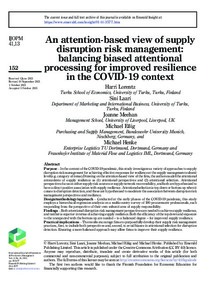An attention-based view of supply disruption risk management: balancing biased attentional processing for improved resilience in the COVID-19 context
Lorentz Harri; Laari Sini; Meehan Joanne; Essig Michael; Henke Michael
https://urn.fi/URN:NBN:fi-fe2022012710758
Tiivistelmä
Purpose
In the context of the COVID-19 pandemic, this study investigates a variety of approaches to supply disruption risk management for achieving effective responses for resilience at the supply management subunit level (e.g. category of items). Drawing on the attention-based view of the firm, the authors model the attentional antecedents of supply resilience as (1) attentional perspectives and (2) attentional selection. Attentional perspectives focus on either supply risk sources or supply network recoverability, and both are hypothesised to have a direct positive association with supply resilience. Attentional selection is top down or bottom up when it comes to disruption detection, and these are hypothesised to moderate the association between disruption risk management perspectives and resilience.
Design/methodology/approach
Conducted at the early phases of the COVID-19 pandemic, this study employs a hierarchical regression analysis on a multicountry survey of 190 procurement professionals, each responding from the perspective of their own subunit area of supply responsibility.
Findings
Both attentional disruption risk management perspectives are needed to achieve supply resilience, and neither is superior in terms of achieving supply resilience. Both the efficiency of the top down and exposure to the unexpected with the bottom up are needed – to a balanced degree – for improved supply resilience.
Practical implications
The results encourage firms to purposefully develop their supply risk management practices, first, to include both perspectives and, second, to avoid biases in attentional selection for disruption detection. Ensuring a more balanced approach may allow firms to improve their supply resilience.
Originality/value
The results contribute to the understanding of the microfoundations that underpin firms' operational capabilities for supply risk and disruption management and possible attentional biases.
Kokoelmat
- Rinnakkaistallenteet [27094]
